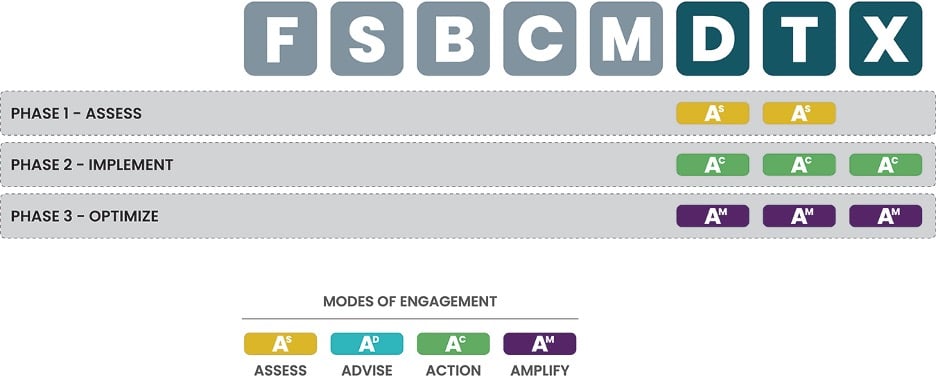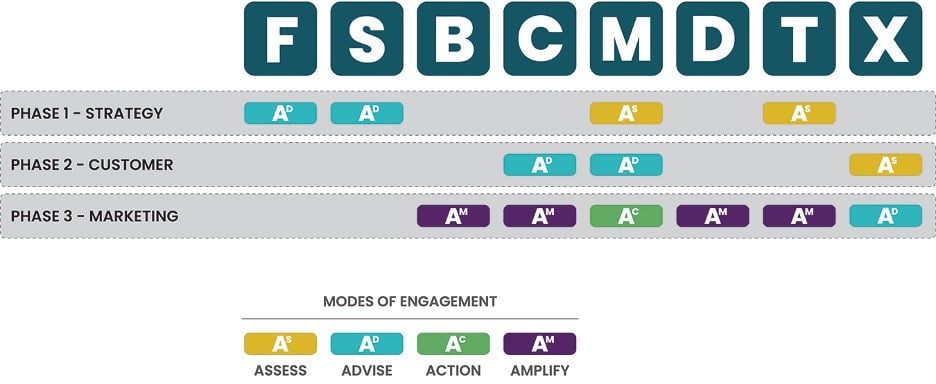Iterating on Products, Services, and Messaging
by Matt, on 15 Jun 2021
Like all good businesses, Strategic Piece constantly experiments with different ways to explain what we do, for whom, and why.
While product-based businesses have a relatively easy time showcasing their solution – many of our favorite websites are built by companies selling software, for example – it can be trickier to explain and promote services.
This is especially true when you offer a range of services, as is the case at Strategic Piece.
We are a hybrid of a strategy consultancy, a marketing agency, and a HubSpot partner. As a result, we offer services within each of those domains as well as some that straddle the boundaries.
An important aspect to convey is that we combine as few or as many of those services as necessary to tackle each client’s specific needs.
While we can – and do – provide the whole kit and kaboodle to some clients, it’s more common for us to focus on one or two areas and dig in deeper there.
Unfortunately, this level of flexibility can lead to “how long’s a piece of string” answers to the simple question “what can you do for me?”
Some prospects also ask whether we have a “packaged” solution for companies like them.
Hmm, we thought. How might we productize our services to reduce the friction we experience during some of these project-scoping conversations?
Productizing What We Do – The Eight Themes
Our first step was to group our services under a set of distinct headings.
This took a bit of trial-and-error, but we eventually got comfortable with eight themes:
- Foundations – for things like purpose, mission, vision, objectives, differentiators.
- Strategy – for, well, strategy.
- Brand – for work related to corporate identity and customer perception.
- Customer – for developing customer analysis and understanding.
- Marketing – for everything from messaging to campaigns.
- Data Management – for activities related to cleaning, migrating, formatting, storing, and using data.
- Technology – for anything around the tech stack and how it is deployed to help automate and scale the customer experience.
- Customer Experience – for the overarching work that brings together and delivers an information-driven customer experience.
It was all going so well. Then we realized two of them start with “C”. Thankfully, we can be trendy and use “X” for customer experience (as in, CX). Crisis averted.
Suddenly we had created eight products – a package of services we could offer to solve challenges related to a specific area of a client’s business.
Viewing themes as building blocks means that we can assemble projects that cover multiple themes.
For example, a HubSpot installation and roll-out might incorporate M, D, T, and X elements – formatting data, moving it into the new CRM, configuring the tech to support marketing goals and initiatives, and aligning the marketing and sales team around a single source of record as they deliver their customer experience.
The Time Dimension
A model is only considered useful if it reproduces reality to a reasonable degree of accuracy.
So, before deploying our new themes in anger, we had to test whether they could be used to describe projects we had already completed.
Zap. (That’s the sound of a lightning bolt striking down a great idea).
We quickly realized that our projects aren’t quite that simple. Bummer, eh?
Most projects go through phases. And the themes we target sometimes change from phase to phase.
Even if the themes don’t change, the amount of effort and attention often shifts significantly between them as the project unfolds.
Hmm, we thought again. How might we show this progression over time without unduly complicating our neat new productized structure?
Projectizing What We Do – The Four Modes
After additional review and reflection, we identified four modes of operation that capture how we modulate our level of engagement on a particular element over time:
- Assess – when we’re evaluating the status quo and identifying opportunities for improvement that relate to the client’s challenge.
- Advise – when we’re guiding the client on analyzing and improving an element while they do most of the legwork.
- Action – when we act as an extension of the client’s team, providing additional skills and bandwidth and doing some of the heavy-lifting.
- Amplify – when we’re providing support as the client moves past implementation into embedding and executing new skills, technology, and processes.
Armed with this new set of labels, we could create project maps that realistically depict the phased evolution of our projects.
For example, here’s a HubSpot implementation that comprised an initial assessment, an implementation phase where Strategic Piece did most of the setup work, and an optimization phase where we continued supporting the client as they adopted the new platform:

And here’s a more complex project where our initial role was to guide the team on gaining clarity around purpose and strategy. Next, we shifted gears to help them deepen and clarify their customer understanding, before ultimately providing fractional CMO support to help optimize their marketing and customer experience:

Putting These Concepts to Work
While we’re having a lot of fun playing with our new building blocks, the real objective was to develop a framework that streamlines conversations with prospects and clients.
That’s the new chapter we begin writing today.
We’ve updated our website to explain the eight themes and the four levels of engagement – accompanied by a few more examples like the ones shown above.
Our antennae are up, listening for changes in the questions we receive from prospective clients.
Are they any clearer about what we do? Does the new nomenclature help?
We still offer a broad range of services that can be combined to make the perfect length piece of string … but hopefully, we’ve simplified the process of getting to that perfect combo.
Look out for an upcoming series of videos and blog posts that focus on our eight key themes. We welcome your feedback!
OTHER RECOMMENDED POSTS
Behind The Scenes: Questions With Melanie
Finding Strategic Peace
Customer Journey Mapping: Are We There Yet?



